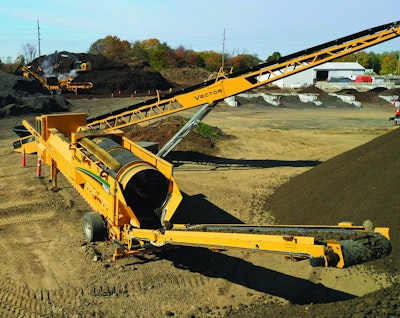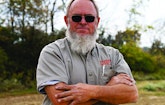Interested in Debris?
Get Debris articles, news and videos right in your inbox! Sign up now.
Debris + Get AlertsJohn Ritter is OK with change. He began his career doing plumbing and utility work, segued into directional drilling pipeline projects and, when storm debris led to an opportunity to supply landscape materials, he jumped into that too.
Ritter Plumbing Company dates back to 1950 and was founded in Englewood, Ohio, by Ritter’s father Phillip Ritter II. Almost 30 years later, when John Ritter graduated from high school, he joined his father and brother, Phillip III, in the family business which had moved 10 miles away to Brookville.
Over time, the company broadened its specialty — repairing and installing underground water and natural gas lines — to include electric conduit and eventually horizontal directional drilling.
Yet through all the changes, the Ritters have valued their Vermeer equipment, relying on the brand for three decades. Ritter Company purchased 10 HDD units throughout the course of offering the service, all from Vermeer.
Business was good, but Ritter was ready for a shift. He sold the company to his brother’s son, Phillip Ritter IV, who has since doubled the number of employees to 85. “I didn’t have the desire to expand it at this stage in my career and Phil did.”
Which is not to say the 63-year-old businessman retired to go deer hunting with his grandchildren and otherwise take it easy. Instead, he launched the landscape materials division of the family company and now devotes his energy to building it out — once again with equipment from Vermeer and this time, with added help from storm debris.
DEBRIS DOLLARS
In 2019, a Memorial Day tornado ripped through Brookville and set the stage for expansion. Ritter responded to the disaster by letting recovery crews dump uprooted trees on the same property where the soil was piled and it didn’t take long for him to see the opportunity to capitalize on the material.
The company bought a Vermeer HG4000 horizontal grinder and put it to work, reducing the storm debris to 10,000 cubic yards of a coarse mulch product. Since that storm, tree trimmers, landscape companies and land developers regularly rid themselves of everything from brush to logs at Ritter’s.
The mulch side of the business grew and, as it did, the handling of the product became more and more refined and systematized. Currently stockpiled on the property is roughly 7,000 cubic yards of coarsely mulched material.
The HG4000 grinder first processes wood debris by chewing it into roughage, which Ritter calls “first grind.” That material is piled up and remains largely untouched for a year to begin the composting process. Then, different perforated plates are fitted to grinder or trommel to create seven different grades of mulch ranging down to “ultra,” a really fine landscape material.
AVOIDING DISASTER
One issue with piling mulched wood in such quantities is the heat generated by the microbial degeneration of the organic material. While a little heat is wanted, bursting into flame is something else. So, the material periodically is stirred to defuse the heat buildup.
John Ritter has another plan moving forward. He asked a local plumbing company to lend him a drone so he can get aerial photos of the piled material. He’s looking to friends in the irrigation business for advice on how to create a spray system to discourage combustion. He plans to connect a 3-inch pipe to the city water system, run it 400 feet to the composting piles and erect four towers in strategic places to bombard the mulch with water from above.
“We’re trying to keep the heat down,” he says. “If you get too much heat and spark a fire on a windy day, you have a problem.”
BUSINESS BREAKDOWN
Most of the ground-up wood product is from hardwoods growing in verdant northern Ohio — oaks, maples, ash.
The company continues to develop efficiencies in its operation. To help quickly move either “first grind” or finished mulch product to a respective pile, Ritter bought an 80-foot Vector VT80 conveyor. To protect its topsoil from the elements over the coming winter, he erected a 60-foot-by-120-foot domed structure that rests on 6-foot-high cement-block foundations. The conveyor can deposit a pyramid of soil 30 feet high under the dome.
“We can put 2,500 cubic yards of soil under that roof, have it here all winter and be ready for customers in the spring,” he says. A wheel loader moves the protected topsoil around under the roof as needed and, come spring, will feed the conveyor or dump the rich soil into backed-in quad-axle dump trucks.
One thing for sure, the company is not likely to run out of organic debris to mulch, Ritter says. The current breakdown of business volume is 40% mulch, 40% topsoil and the other 20% is sand and gravel. Customers are property owners, landscape companies and small contractors. “It’s getting harder for homeowners who need just a yard or two of gravel to get into gravel pits. They can buy it from me.”
Ritter and two yard employees can operate the user-friendly Vermeer screening and grinding machines. “They are specialty-enough machines that it’s not like getting on a backhoe or something,” Ritter says, “but the remote controls for each machine are somewhat the same. It’s easy to push the automatic button, dump in material and let it do its work.”
Realizing an opportunity when tornado debris was dropped on his property and utilizing the right equipment, Ritter brought a whole new segment of income to the family business. Storms leave debris, but it doesn’t have to be waste.








